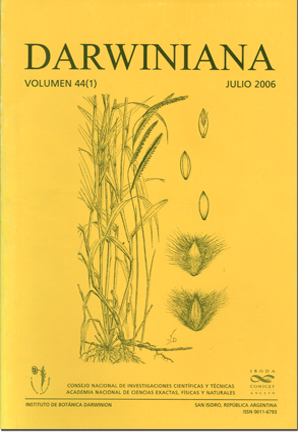Cuticular wax linear alkanes in leaves of Populus alba, Populus deltoi- des (Salicaceae), Robinia pseudoacacia (Fabaceae), Ulmus pumila (Ulmaceae) and Fraxinus americana (Oleaceae) from Tandil, Buenos Aires, Argentina
DOI:
https://doi.org/10.14522/darwiniana.2014.441.120Keywords:
Populus, Robinia, Ulmus, Fraxinus, linear alkanes, cuticular waxAbstract
Mature leaves of adult individuals of Populus alba, Populus deltoides, Robinia pseudoacacia, Ulmus pumila and Fraxinus americana from the University Campus, Tandil, Buenos Aires, Argentina (37° 19’S, 59° 08’W) were collected on February 2004. The cuticular wax was extracted, purified, and the content and relative proportion of odd-carbon numbered n-alkanes (C23→C35) was quantified by capillary gas-liquid chromatography. Total concentration of n-alkanes (mg/kg DM) were P. alba (6935) > Robinia (1571) > P. deltoides (1379) > Ulmus (880) > Fraxinus (467). Most abundant n-alkanes in all species were C27 and C29 accounting for 10-51% and 35-76% of total, respectively, except Fraxinus where most abundant were C29 and C31 accounting for 31% and 41% of total, respectively. P. alba and P. deltoides differed not only in total concentration of all n-alkanes but also in relative proportion of C27 and C29, being C29 the most abundant in the latter species (76%) as well as in Robinia (75%). The occurrence of even-carbon numbered n-alkanes was either undetectable or very low in all species in general, except for C26, C28 and C30, the latter being prominent in Fraxinus.Downloads
Published
31-07-2006
How to Cite
Bakker, M. L., & Alvarado, P. I. (2006). Cuticular wax linear alkanes in leaves of Populus alba, Populus deltoi- des (Salicaceae), Robinia pseudoacacia (Fabaceae), Ulmus pumila (Ulmaceae) and Fraxinus americana (Oleaceae) from Tandil, Buenos Aires, Argentina. Darwiniana, Nueva Serie, 44(1), 58–63. https://doi.org/10.14522/darwiniana.2014.441.120
Issue
Section
Invited paper
License

Starting on 2012, Darwiniana Nueva Serie uses Licencia Creative Commons Atribución-NoComercial 2.5 Argentina .






